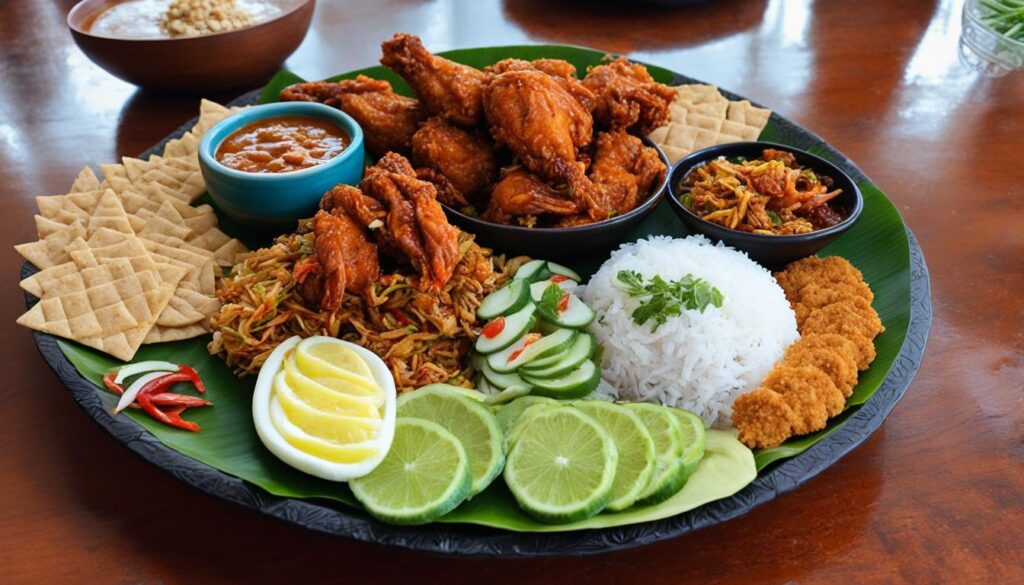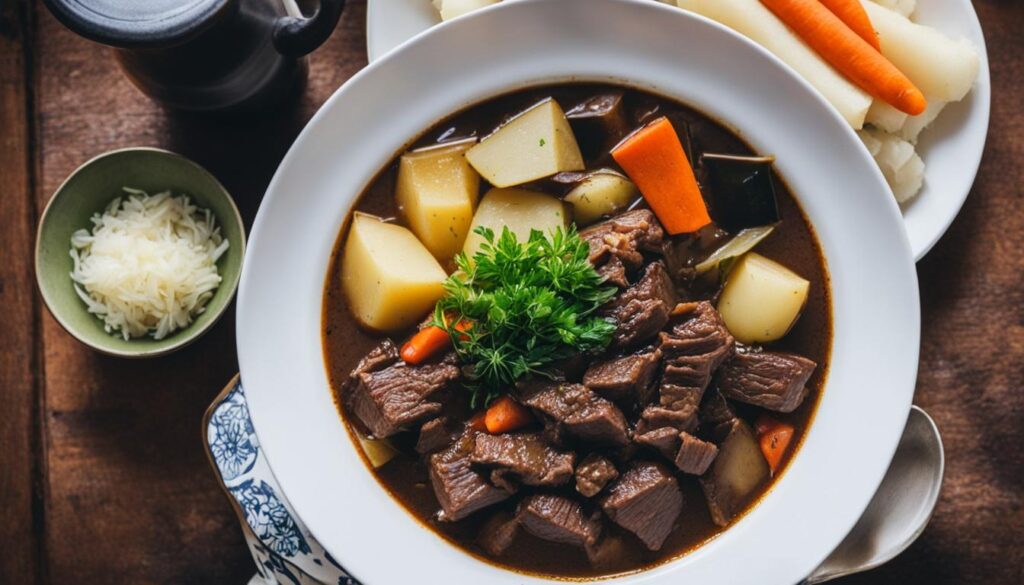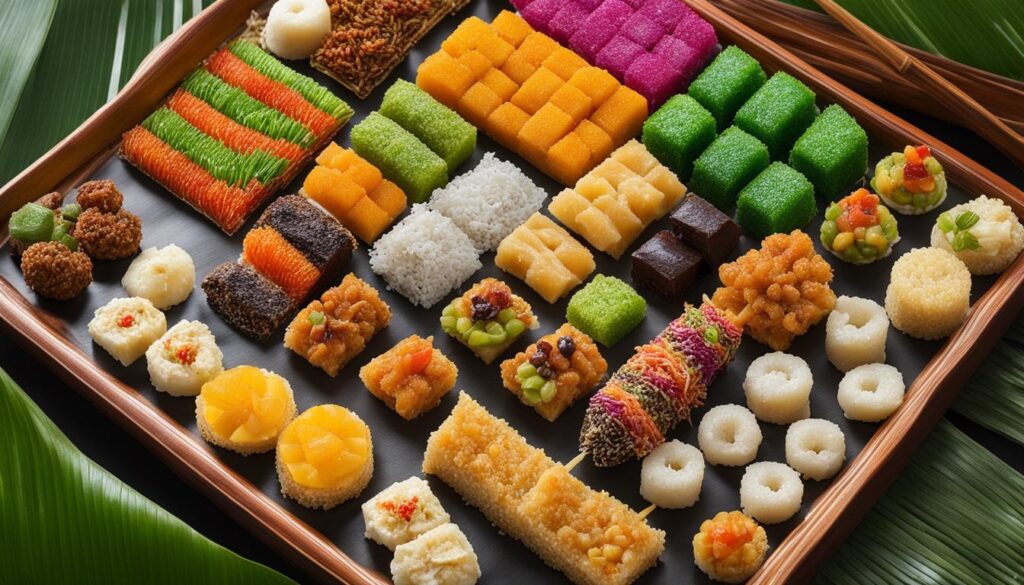You may have heard of rawon and lontong balap, popular dishes that are synonymous with Suroboyan cuisine. However, if you want to experience authentic Suroboyan cuisine, there’s much more to explore beyond these dishes. Suroboyan cuisine is a testament to the rich culinary heritage of Indonesia, with traditional Javanese flavors that are unique to the region.
Join us as we venture into the world of Suroboyan cuisine, unearthing hidden gems, exploring regional variations, and savoring the diverse flavors that define this culinary experience. From traditional snacks to hearty beef stews, we’ll take you on a journey through the streets and markets of Suroboyan, where you can discover the authentic Suroboyan cuisine beyond rawon and lontong balap.
Get ready to indulge your senses and taste buds with unique Suroboyan dishes that will leave you wanting more. Let’s dive into the depths of Suroboyan cuisine and experience the true essence of this Indonesian culinary gem.
Unearthing Hidden Gems of Suroboyan Cuisine
While rawon and lontong balap are popular Suroboyan dishes, there are many other unique Suroboyan delicacies that are waiting to be discovered. In this section, we reveal the hidden gems of Suroboyan cuisine that showcase the distinct flavors and cooking techniques specific to the Suroboyan region.
One of these hidden gems is rongsok, a dish made from leftover fried tempeh with herbs and spices. Another must-try dish is kupang lontong, a combination of lontong, sayur asam soup, and small saltwater clams. For those who love spicy food, plecing kangkung is a popular vegetable dish with an added kick of chili sambal.
Experience the unique flavors of Suroboyan cuisine by venturing beyond the usual dishes and trying these hidden gems.
Exploring Traditional Javanese Flavors
Suroboyan cuisine is rooted in the traditional Javanese flavors that are prevalent in the region. These flavors are a result of the blend of different cultures that have influenced Javanese cuisine over the centuries. Key ingredients like coconut milk, turmeric, and peanuts are common in both Javanese and Suroboyan cooking.
Suroboyan cuisine is also famous for its use of herbs and spices like coriander, cumin, and lemongrass. These seasonings lend a unique taste to the dishes and make them distinct from other Indonesian cuisines.
To achieve the authentic taste of traditional Javanese flavors, Suroboyan cuisines incorporate slow-cooking techniques that allow the flavors to seep in thoroughly. The use of charcoal to cook dishes also gives them a characteristic smoky flavor.
“The rich blend of flavors in Suroboyan cuisine is a reflection of its rich history. The culinary traditions of the region fuse the best of Java’s heritage with unique local ingredients and techniques”.
Beyond Rawon: Savoring Suroboyan Beef Stews
If you thought that rawon was all there was to Suroboyan beef stews, you’re in for a treat. The Suroboyan region has an array of other beef stews that offer unique and flavorful experiences. From tender meat to rich sauces, these beef stews are an excellent way to dive deeper into Suroboyan cuisine.
For a taste of the region’s culinary diversity, try dishes such as kalio, semur, or gulai, which all feature distinct combinations of spices and herbs. These stews are usually served with rice or lontong (rice cakes) and often accompanied by fried shallots or emping (melinjo nut crackers) for added texture.
What makes Suroboyan beef stews truly special is the use of local ingredients and the cooking techniques that have been passed down through generations. The traditional slow-cooking method used in making these stews not only infuses the meat with rich flavor but also ensures a tender and satisfying dining experience.
So go beyond the well-known rawon and discover the many other flavorful beef stews that Suroboyan cuisine has to offer. Your taste buds will thank you.
Lontong Balap and More: Exploring Suroboyan Street Food
When it comes to Suroboyan cuisine, street food plays a crucial role in the culinary experience. One of the most iconic street food dishes is lontong balap, a rice cake dish served with bean sprouts, tofu, and a savory peanut sauce. But there’s so much more to discover!
For a truly authentic Suroboyan street food experience, try out some of these other delectable dishes:
| Dish | Description |
|---|---|
| Sate Klopo | Grilled coconut-infused chicken skewers served with a spicy peanut sauce and shredded coconut. |
| Tahu Telor | Deep-fried tofu and egg frittata served with a sweet and spicy sauce. |
| Tahu Campur | A mixed bean sprout and tofu salad served with a savory peanut sauce. |
| Kroket Singkong | Crispy cassava croquettes filled with chicken or beef ragout. |
These dishes and many more can be found at bustling street food markets or from street vendors all over Suroboyan. Don’t be afraid to explore and try something new!
Traditional Suroboyan Snacks and Desserts
When it comes to authentic Suroboyan cuisine, the sweet treats are just as important as the savory dishes. Traditional Javanese flavors continue to shine through in the array of snacks and desserts that are integral to the Suroboyan culinary experience.
One popular snack is kue pisang, a banana cake made with sweet bananas, flour, sugar, and coconut milk. Other popular sweet snacks include klepon, round balls made from glutinous rice flour and filled with melted palm sugar, and onde-onde, chewy balls filled with sweet mung bean paste and covered with sesame seeds.
As for desserts, one standout is jenang grendul, a sweet soup made with grendul (green rice flour jelly), coconut milk, and palm sugar. Another popular dessert is lapis legit, a layered cake made from butter, eggs, and spice mixture such as cinnamon, nutmeg, and cardamom.
These traditional Suroboyan snacks and desserts are not only delicious but also reflect the rich culinary heritage of Indonesia. No Suroboyan culinary experience is complete without indulging in these delightful treats.
Influences from Other Cultures in Suroboyan Cuisine
Suroboyan cuisine reflects a blend of flavors and techniques influenced by various cultures. The authentic taste of Suroboyan dishes is a testament to the country’s rich history and diversity. Throughout the years, Suroboyan has adopted cooking methods, ingredients, and flavors from other cultures and incorporated these elements into their traditional cuisine, creating unique and flavorful dishes that are woven into the Suroboyan culinary experience.
The Indonesian culinary heritage has also played a significant role in shaping Suroboyan cuisine. Due to the country’s history as a trading post, the cuisine has been influenced by Chinese, Indian, and Arab flavors. The use of soy sauce, garlic, and ginger in Suroboyan cuisine trace back to the Chinese merchants who traveled to Indonesia to trade spices and goods.
The Dutch had colonized Indonesia in the early 19th century, and their influence on Indonesian cuisine is evident in Suroboyan dishes’ use of ingredients like potatoes, cabbage, and carrots. The Dutch also introduced bread and baked goods, which have become an integral part of Suroboyan cuisine.
The Javanese culture heavily influenced Suroboyan cuisine, and the use of spices like turmeric, coriander, and tamarind, commonly found in traditional Javanese dishes, can also be found in many Suroboyan dishes.
“The fusion of flavors and cooking techniques from different cultures has created a unique and unforgettable experience for anyone who takes the time to savor authentic Suroboyan cuisine.”
Suroboyan’s diverse culinary heritage offers a glimpse into the country’s fascinating history and is an essential element in the Suroboyan culinary experience. Understanding the influences from other cultures on Suroboyan cuisine adds an extra layer of appreciation and enjoyment for anyone who indulges in the unique and authentic flavors of this remarkable cuisine.
Regional Variations in Suroboyan Cuisine
As you explore Suroboyan cuisine, you’ll quickly realize that the region’s diverse culinary heritage is not limited to traditional Javanese dishes. Each town and village in the Suroboyan region has its own unique interpretation of these classic recipes, resulting in a wide variety of distinct flavors and cooking styles.
For instance, the lontong balap in Surabaya uses a distinct peanut sauce, while the version in Gresik features a spicy tomato sauce. In Lamongan, locals love to indulge in their own twist on the traditional sate kambing (grilled lamb skewers) that are slowly cooked over charcoal fire, which provides a unique smoky flavor.
Another regional variation that you’ll find is nasi pindang, a fragrant rice dish cooked in a tangy broth made with tamarind leaves and garlic. This dish is a testament to the incredible diversity that exists within Suroboyan cuisine and exemplifies how the culinary journey in this region is full of surprises.
Indeed, exploring the different regional variations of authentic Suroboyan cuisine is integral to experiencing the full range of flavors and ingredients that make up this unique culinary culture. No matter where you go in the Suroboyan region, you can be sure to discover something new that will surprise and delight your taste buds.
Traditional Cooking Methods and Techniques
Authentic Suroboyan cuisine is steeped in tradition and heritage, with cooking methods that have been passed down through generations. The intricate techniques used to prepare these dishes require patience, skill, and attention to detail, ensuring that each dish is a masterpiece in its own right.
One of the essential components of Suroboyan cuisine is the use of traditional cooking equipment such as the “dapur” (stove), “unggahan” (work surface), and “anglo” (clay pots), which allows the flavors of each ingredient to meld together perfectly.
Another crucial aspect of Suroboyan cuisine is the focus on using fresh, local ingredients that are in season, which not only imparts a unique flavor to the dish but also supports the local farmers and economy. Many dishes are also slow-cooked, allowing the flavors to develop and intensify over time, creating bold and delicious taste profiles.
The use of distinctive herbs and spices such as galangal, tamarind, and kaffir lime leaves infuses the dishes with a complex depth of flavor that is a hallmark of traditional Javanese cuisine. In addition, the preparation of spice pastes known as “bumbu” is another vital aspect of Suroboyan cooking, where spices are pounded together to create a potent blend of flavor.
Overall, the importance of heritage cooking methods and techniques in Suroboyan cuisine cannot be overstated. It is these practices that have preserved the authenticity of the flavors and made Suroboyan cuisine a must-try for anyone seeking a genuine Indonesian culinary experience.
“Suroboyan cuisine is an art form, and the techniques used in cooking are essential to bring out the true flavors of each ingredient.”
Where to Experience Authentic Suroboyan Cuisine
Ready to savor the unique flavors of authentic Suroboyan cuisine? Here are some recommendations on where to experience the best of Suroboyan culinary delights:
Restaurants
Restoran Solo Suroboyo is a popular choice for those seeking an authentic Suroboyan culinary experience. Their menu features a variety of Suroboyan dishes, including rawon and sate klopo, all cooked with traditional recipes and techniques. Kedai Pak Udin is another must-visit restaurant, known for its delicious lontong balap and soto ayam. Seating is limited, so be sure to arrive early to secure a table.
Food Markets
For a taste of Suroboyan street food, head to Pasar Keputran, a bustling food market in Suroboyo. Here you’ll find an array of street food vendors selling everything from nasi liwet to bakso, along with the famous lontong balap. Another must-visit market is Pasar Genteng, where you can indulge in traditional Suroboyan snacks like lemper and nagasari.
Local Eateries
If you’re looking for a more casual setting, try some of Suroboyo’s local eateries. Warung Bu Kris is a popular chain eatery, serving up a variety of traditional Javanese dishes, including Suroboyan specialties like lontong sayur and sate kelopo. If you’re in the mood for something sweet, head to Toko Oen, a quaint dessert shop that’s been around since the 1930s, famous for its homemade ice cream and traditional Dutch-Indonesian sweets.
Conclusion
Congratulations for venturing into the world of Suroboyan cuisine beyond the usual rawon and lontong balap! Your exploration has provided a glimpse into the rich Indonesian culinary heritage and the unique flavors of authentic Suroboyan cuisine. By delving into the lesser-known dishes, you have discovered hidden gems that showcase the distinct cooking techniques specific to the Suroboyan region.
It is essential to note that traditional Javanese flavors are prevalent in Suroboyan cuisine, and the key ingredients, spices, and cooking methods give these dishes their unique taste. The regional variations within Suroboyan cuisine add further depth and diversity to the culinary experience. To preserve the authenticity of the flavors, it is crucial to use heritage cooking practices.
You are now equipped with recommendations for experiencing authentic Suroboyan cuisine at restaurants, food markets, and local eateries. Embrace the unique Suroboyan culinary experience and continue to explore the diversity of traditional Javanese cuisine.

















































